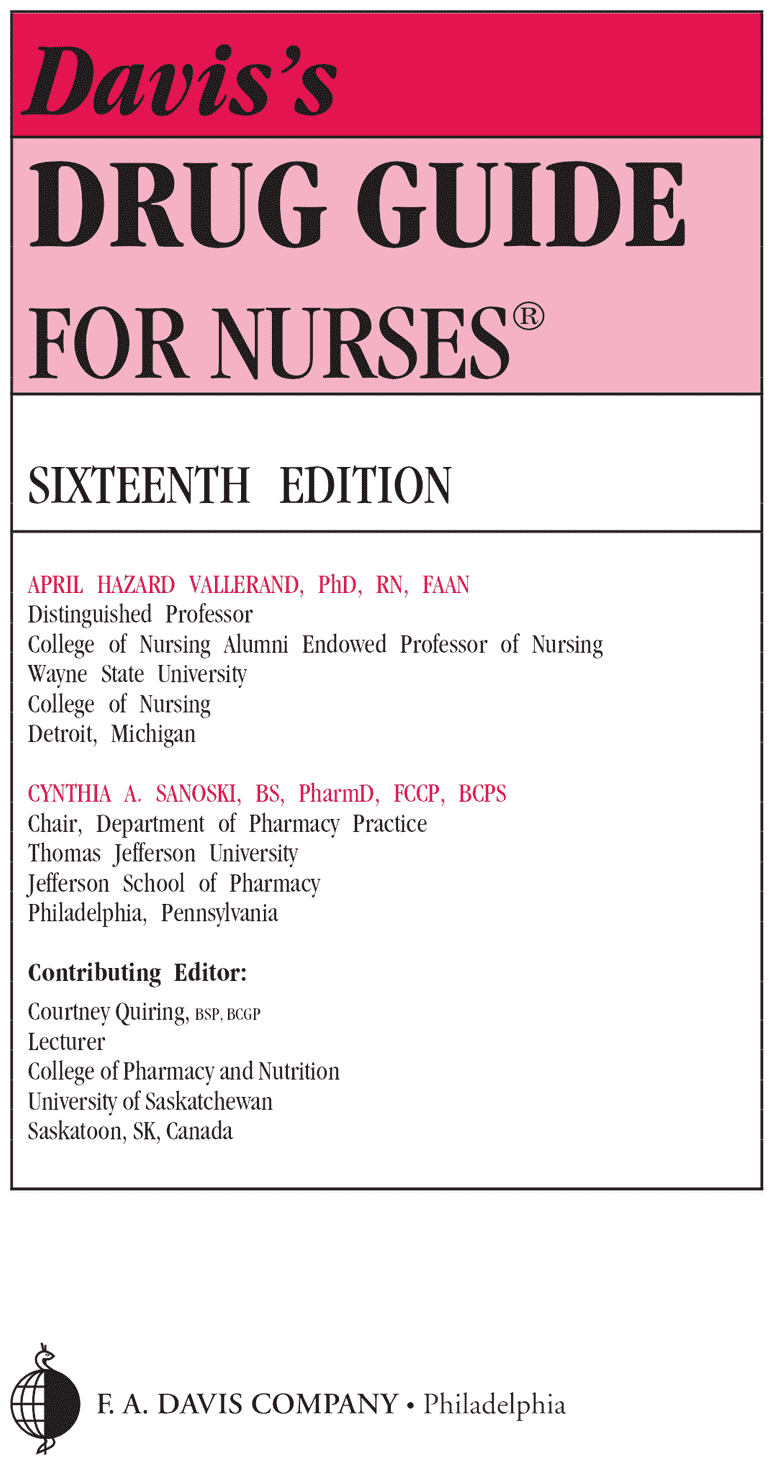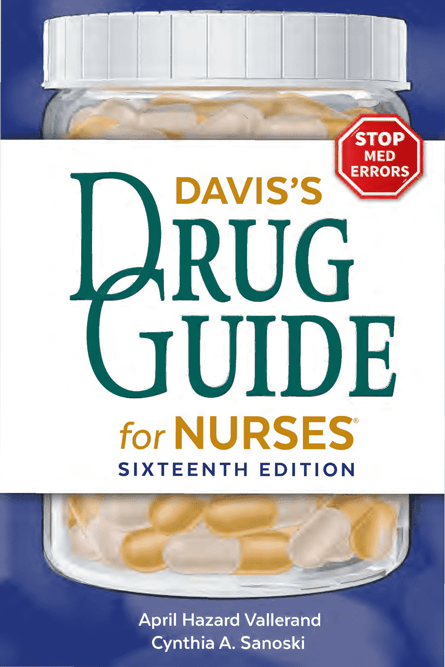

Davis’s Drug Guide for Nurses 16th edition (Sixteenth Edition)
Author(s): Leiyu Shi, Douglas A. Singh
Publisher: F.A. Davis Company, (June 1, 2018)
ISBN: 9780803669451

HOW TO USE DAVIS’S DRUG GUIDE FOR NURSES
Davis’s Drug Guide for Nurses provides comprehensive, up-to-date drug information in well- organized, nursing-focused monographs. It also includes extensive supplemental material in 16 appendices, thoroughly addresses the issue of safe medication administration, and educates the reader about 50 different therapeutic classes of drugs. In this 16th edition, we have continued the tradition of focusing on safe medication administration by including Medication Safety Tools and even more information about health care’s most vulnerable patients: children, the elderly, pregnant women, and breast feeding mothers.
Look for more Pedi, Geri, OB, and Lactation headings throughout the monographs. In addition, we’ve included information relevant to Canadian students and nurses. You’ll find an appendix comparing Canadian and U.S. pharmaceutical practices, more Canada-only combination drugs in the Combination Drugs appendix, and additional Canadian brand names in the drug monographs. To help you find this information quickly, we’ve also added a maple leaf icon ( ) in the index next to each Canadian entry. We have added pharmacogenomic information throughout numerous monographs to guide the nurse in selecting and monitoring various drug therapies.
To help you find this information quickly, we’ve added a double helix icon ( ) to denote this information as it applies to specific drugs. Use this book to enhance your competence in implementing and evaluating medication therapies. The following sections describe the organization of Davis’s Drug Guide for Nurses and explain how to quickly find the information you need.
Safe Medication Use Articles
“Medication Errors: Improving Practices and Patient Safety,” “Detecting and Managing Adverse Drug Reactions,” “Overview of Risk Evaluation and Mitigation Systems (REMS),” “Special Dosing Considerations,” and “Educating Patients About Safe Medication Use” comprise the safe medication use articles and provide an overview of the medication safety issues that confront practitioners and patients.
Leading off this series, the medication errors article familiarizes you with the systems issues and clinical situations repeatedly implicated in medication errors and suggests practical means to avoid them. It also teaches you about high alert medications, which have a greater potential to cause patient harm than other medications. “Detecting and Managing Adverse Drug Reactions” explains the different types of adverse reactions and provides guidance on how to detect and manage them. “Risk Evaluation and Mitigation Strategies (REMS)” explains strategies developed by the pharmaceutical industry and required by the Food and Drug Administration (FDA) to minimize adverse drug reactions from potentially dangerous drugs. We have highlighted the drugs that currently have approved REMS programs associated with their use by adding a REMS label at the top of applicable drug monographs.
“Special Dosing Considerations” identifies the patient populations, such as neonates and patients with renal impairment, who require careful dose adjustments to ensure optimal therapeutic outcomes. “Educating Patients About Medication Use” reviews the most important teaching points for nurses to discuss with their patients and their families. In addition to these safety articles, other critical information is highlighted in red throughout the drug monographs. This allows the reader to quickly identify important information and to see how nursing practice, including assessment, implementation, and patient teaching, relates to it
Classifications Profile
Medications in the same therapeutic class often share similar mechanisms of action, assessment guidelines, precautions, and interactions. The Classifications Profile provides summaries of the major therapeutic classifications used in Davis’s Drug Guide for Nurses. It also provides patient teaching information common to all agents within the class and a list of drugs within each class.
Medication Safety Tools
Updated for this edition is a section with tables and charts that nurses can use for a quick but thorough reference to information that will help them avoid making medication errors. It includes lists of drugs that are associated with adverse reactions and falls in the elderly; proper dosing for pediatric intravenous medications; confused drug names; FDA-approved Tall Man letters and more.
Drug Monographs
Drug monographs are organized in the following manner:
High Alert Status: Some medications, such as chemotherapeutic agents, anticoagulants, and insulins, have a greater potential for harm than others. These medications have been identified by the Institute for Safe Medication Practices as high alert drugs. Davis’s Drug Guide for Nurses includes a high alert tab in the upper right corner of the monograph header in appropriate medications to alert the nurse to the medication’s risk. The term “high alert” is used in other parts of the monograph as well, to help the nurse administer these medications safely. See the article “Medication Errors: Improving Practices and Patient Safety” for a complete list of high alert medications in Davis’s Drug Guide for Nurses. Refer to ISMP.org for all solutions, groups, and individual high alert drugs.
Generic/Brand Name: The generic name appears first, with a pronunciation key, followed by an alphabetical list of trade names. Canadian trade names are preceded by a maple leaf ( ). Brand names that have been discontinued have a slash through them (Decadron). Common names, abbreviations, and selected foreign names are also included.
Classification: The therapeutic classification, which categorizes drugs by the disease state they are used to treat, appears first, followed by the pharmacologic classification, which is based on the drug’s mechanism of action.
Controlled Substance Schedule: All drugs regulated by federal law are placed into one of five schedules, based on the drug’s medicinal value, harmfulness, and potential for abuse or addiction. Schedule I drugs, the most dangerous and having no medicinal value, are not included in Davis’s Drug Guide for Nurses. (See Appendix I for a description of the Schedule of Controlled Substances.)
Pregnancy Category: The FDA recently recommended discontinuation of the Pregnancy Category system (A, B, C, D, and X) since this categorization may not appropriately communicate the risk that a drug may have during pregnancy or breast feeding. Based on this guidance, the Pregnancy Categories have been removed from each of the drug monographs. These pregnancy letter categories have been replaced in drug prescribing information with a narrative summary that describes the potential risk of using the drug during pregnancy and breast feeding as well as in women and men of reproductive potential. The drug monographs have been enhanced with this detailed information in these patient populations


nsabhaya72 –
Verified Purchase